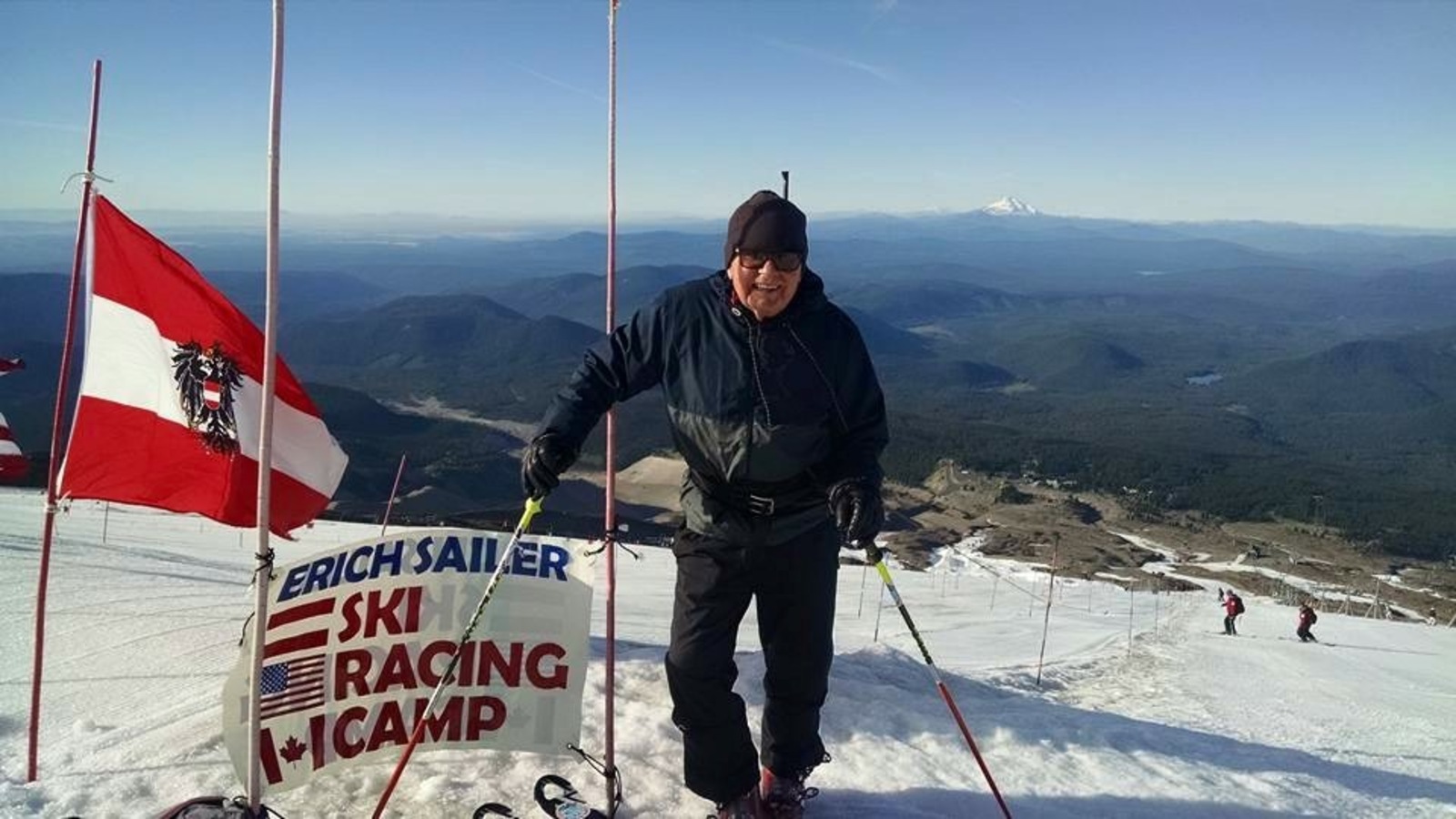
Erich Sailer, the legendary Austrian-born ski coach who transformed American ski racing and inspired generations of athletes, has died at the age of 99. His passing marks the end of a remarkable era in U.S. ski racing, leaving behind a legacy of champions, groundbreaking programs, and an indelible spirit of excellence.
For decades, Sailer was the driving force behind the Buck Hill Ski Team in Burnsville, Minnesota, an unassuming hill that, under his guidance, became one of the nation’s premier training grounds for slalom talent. He was a Hall of Fame coach who developed young skiers who became Olympians, including one of the most successful alpine ski racers in history, Lindsey Vonn. His death was confirmed by Buck Hill Ski and Snowboard Area, where he coached from 1969 to 2022.
Vonn, whose career he profoundly shaped, eloquently summed up his impact, stating, “There is no doubt that I would not be the person or skier I am today without him. The entire ski racing community would not be the same without him. He single handedly did more for skiing than any other coach in America and perhaps the world.” Sailer’s unique blend of rigorous technique, infectious enthusiasm, and unwavering belief in his athletes laid the foundation for countless triumphs, proving that commitment to excellence, not the size of the mountain, makes champions.

1. **The Architect of American Ski Racing**Erich Sailer is widely recognized as a visionary who revolutionized American ski racing, a sport traditionally dominated by European powerhouses. His influence stretched far beyond the modest slopes he coached on, laying the groundwork for a robust developmental system that produced Olympic and World Cup stars. Sailer’s lifelong dedication to the sport and his extraordinary coaching achievements earned him a place in the U.S. Ski and Snowboard Hall of Fame.
He was, as Lindsey Vonn attested, a figure who “single handedly did more for skiing than any other coach in America and perhaps the world.” Sailer’s impact was not confined to individual victories; he was instrumental in creating premier racing programs, particularly from the unlikeliest of places. His philosophy and methods built a lasting framework for success that continues to resonate throughout the ski community.
The legacy Sailer leaves behind is multifaceted, embodied not only in the medals and records of his athletes but also in the very structure of American ski development. His dedication fostered an enduring spirit of excellence and a belief that greatness could emerge from any background. He was the driving force behind the Buck Hill Ski Team, putting a small Minnesota hill “on the map as a premier racing program.”
2. **An Austrian Spirit in America**Born Erich Josef Johann Sailer on November 7, 1925, in Telfs, Austria, a market town near Innsbruck, Sailer’s journey into the world of ski racing began in the majestic Tyrolean Alps. His early life exposed him to a deep-rooted skiing culture, where he honed his skills as a teenager. Although not related to the famed Austrian skiing great Toni Sailer, Erich carved out his own moments of glory, including a third-place finish in the challenging Hahnenkamm downhill race in Kitzbühel in 1950, as a member of Austria’s national ski team.
Sailer’s adventurous spirit led him to emigrate to North America in the 1950s, first arriving in Vancouver in 1954 to coach skiing at the University of British Columbia. His arrival in the United States in 1955, as the story goes, was marked by a particularly humble beginning: “he had thirty-five dollars in his pocket and the only word he knew how to say in English was ‘hamburger.’” This anecdote speaks to his resourcefulness and determination.
Despite the initial linguistic and cultural barriers, Sailer quickly embarked on his mission to build American ski racing. He admitted, in the early days of establishing his camps, “I had to learn a lot.” This humility and willingness to adapt allowed him to pioneer innovative training methods uniquely suited to the American landscape, setting the stage for his revolutionary contributions.

3. **Pioneering Summer Training**Erich Sailer’s innovative vision extended beyond the traditional winter season, as he recognized the need for year-round training to develop world-class skiers. In 1956, shortly after arriving in the U.S., he “pioneered summer ski racing on this continent” by establishing a groundbreaking camp at the Timberline resort on Oregon’s Mount Hood. This initiative was a significant step, setting new standards for ski development in the United States and attracting aspiring racers from around the world.
His early experiences at Mount Hood were not without challenges, as he humorously recalled: “We had 16 injuries in 20 days on the soft snow.” However, Sailer learned and adapted, continuously refining his approach to summer training. This pioneering spirit blossomed, leading to the expansion of his summer programs, which became crucial incubators for future ski stars.
By 1967, Sailer had helped launch another major summer camp on the Beartooth Pass outside Red Lodge, Montana. This camp quickly grew to become “the country’s largest ski-racing camp, attracting 700 skiers for 40-day sessions.” Critically, Sailer’s strategy involved bringing in Olympic and World Cup champions, such as Billy Kidd, Jimmie Heuga, Barbara Ann Cochran, and Egon Zimmermann, to train alongside his young campers. Alan Kildow, Lindsey Vonn’s father and one of Sailer’s earliest athletes, noted, “No other coach was doing that.” This approach aimed to “instill in kids a sense of what it takes to be a champion.”

4. **Buck Hill’s Unlikely Launchpad**In 1969, Erich Sailer made a pivotal move to the Twin Cities area of Minnesota, a region not typically associated with alpine skiing. Here, he found his ultimate canvas: Buck Hill, a sports resort about 20 miles south of Minneapolis. This “modest slope” or “bump of a slalom slope” had little more than 300 vertical feet, a characteristic so unimposing that a reporter once wrote that “escalators at the nearby Mall of America probably have more vertical drop.”
Despite its humble stature, Sailer saw potential in Buck Hill, particularly its suitability for slalom skiing with its 310-foot vertical drop. He transformed this small hill into a “premier developmental ski racing program” and “one of the nation’s premier training grounds for slalom talent.” Under his guidance, Buck Hill became a remarkable launchpad for young hopefuls, putting them on career paths that led to the Olympics and the international World Cup circuit.
Sailer’s success at Buck Hill defied conventional wisdom, demonstrating that it wasn’t the grandeur of the mountain but the intensity and quality of the training that mattered. Using a simple rope-tow lift, providing a quick 45-second ascent and a 20-second descent, skiers under Sailer’s tutelage built unparalleled consistency through repetition. He proved that “a small hill in Minnesota is capable of greatness,” fostering champions from the flatlands.
)
5. **The “Erich Sailer System”: A Philosophy of Repetition and Precision**At the core of Erich Sailer’s extraordinary success was his unique “Erich Sailer System,” a coaching philosophy that meticulously combined rigorous instruction with an infectious enthusiasm for the sport. He cultivated a training environment where discipline and repetition were paramount, instilling in his athletes the fundamental techniques necessary for high-level competition. With hearty encouragement and a jubilant spirit, he motivated young skiers to push their limits.
His training regimen at Buck Hill was famously demanding. Lindsey Vonn, for instance, was known to ski “1,000 gates per day on weekends,” in addition to 400 gates on school days, often including evening sessions under the lights. Sailer himself recounted Vonn’s dedication: “Up and down the mountain, day after day — nights, weekends, holidays — Lindsey was always there, and she never complained.” This relentless focus on high-volume, consistent practice built the muscular memory and precision essential for success.
Sailer’s ability to turn a “small but mighty Buck Hill” into a feeder program for the U.S. Ski Team was a testament to his system’s efficacy. He famously stated, after seeing Buck Hill racers head to the Junior Nationals, “That’s when I said I’m going to put somebody on the U.S. Ski Team from the flatlands.” And he did, with 15 racers from Buck Hill eventually making the team and four competing at the Olympics, proving that “the ‘Erich Sailer System’ worked” through sheer commitment to excellence.

6. **Mentoring a Legend: Lindsey Vonn’s Formative Years**No athlete is more closely associated with Erich Sailer’s transformative influence than Lindsey Vonn, whose legendary career was significantly shaped by his early mentorship. Vonn began training with Sailer at age seven, joining the Buck Hill team and attending his pioneering Mt. Hood camps. By age nine, she was already traveling to Europe with him, an early exposure that laid the crucial foundation for her future international career. She literally “grew up training nightly under the Buck Hill lights” with Sailer’s guidance.
Sailer’s early assessments of Vonn were both candid and prescient. He jokingly called a young Vonn “a turtle,” telling The New York Times that “You could walk faster than she skied” in her first races. Yet, Sailer possessed an innate ability to recognize raw talent and resisted external pressures to change her unique style. When others suggested Vonn alter her technique, Sailer “shook his head,” insisting, “You’re fast the way you are.” Vonn herself called this “the best piece of advice he ever gave me.”
This unwavering belief in her natural abilities profoundly impacted Vonn, who stated, “Erich was more than my ski coach. More than my father’s ski coach. Erich was my family.” She elaborated on his pivotal advice: “Always be true to myself. Never change because I was fast just as I was.” This foundational guidance contributed to Vonn’s fearless attacking style, which led her to become the first (and still only) American woman to win Olympic downhill gold in 2010. Her career blossomed to include four World Cup overall season titles and 82 individual World Cup race victories, making her the most successful skier ever in the speed disciplines and a member of the elite club of those who have won in every individual World Cup discipline.
Even as Vonn ascended to global superstardom, Sailer remained a trusted sounding board and a source of unwavering encouragement. Ahead of her final downhill race before retiring in 2019, Sailer FaceTimed her, telling her, “Of course you can do it! It’s nothing! What’s a minute and a half? I’m ninety-three!” His belief in her never faded; even last year, at 40, when Vonn considered a comeback for the Olympics, Sailer’s reply was steadfast: “Of course you can.” His influence was a constant, empowering force throughout her life and career.




